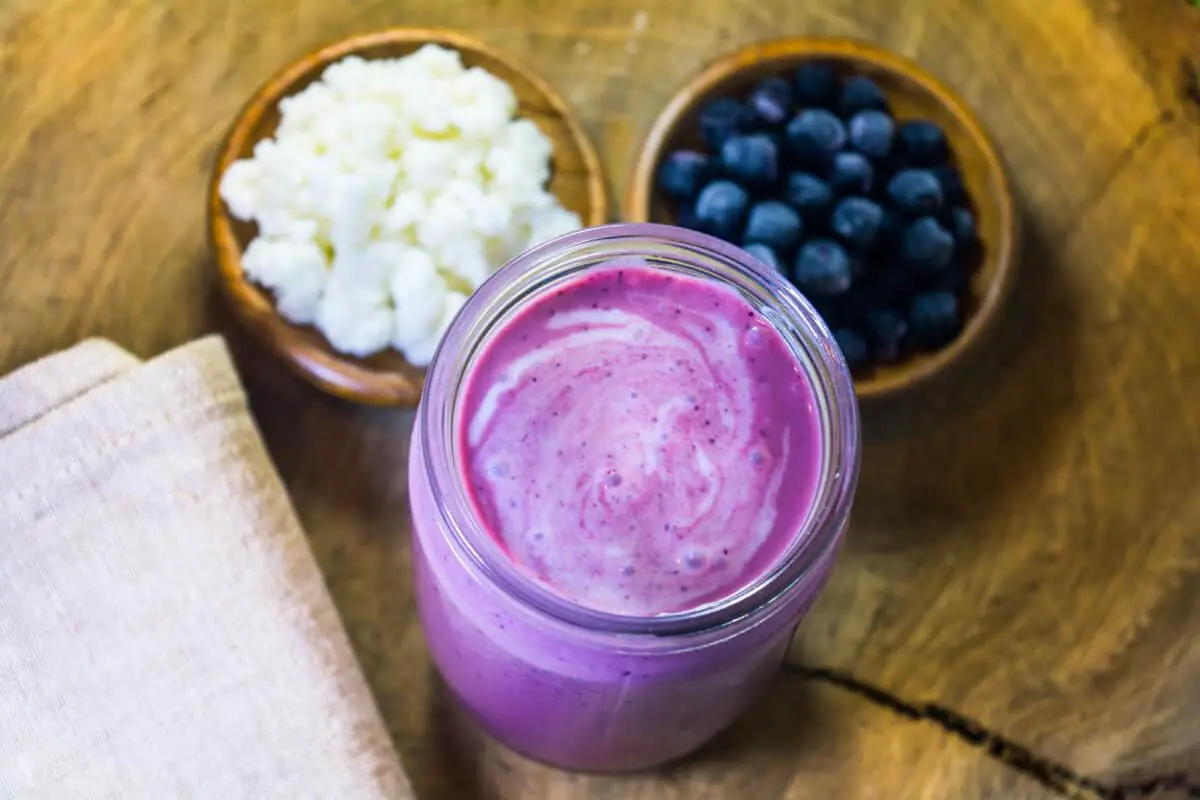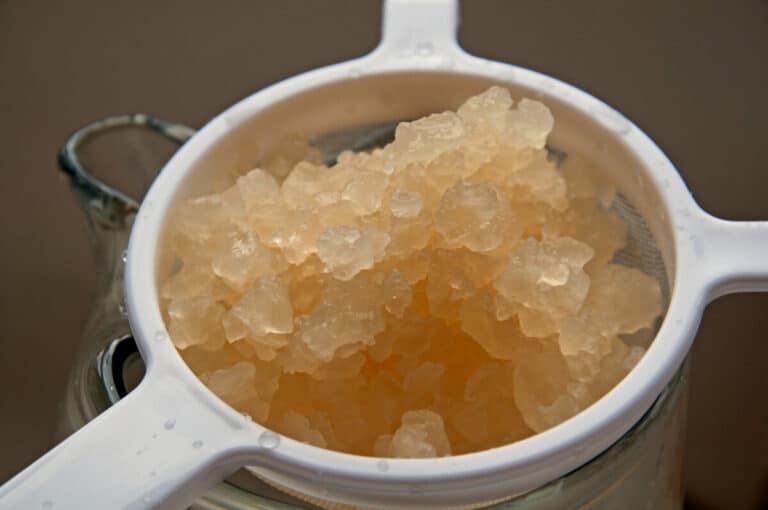Eating Kefir Grains: Here is All You Need to Know
Kefir grains multiply quickly, and you are probably aware of that if you ferment them in your home. When deciding what to do you them, one question often comes to mind: Can I eat them? I was in this situation myself, so I did some research, and here is all I found out.
So, the short answer is: you can eat kefir grains! Water kefir grains and milk kefir grains can be eaten without presenting any health risks. In addition, they are pretty nutritious, to be honest.
There are many ways to eat kefir grains and, because of their composition, they can add some extra nutritional and probiotic value to your smoothies or meals.
Why Can We Eat Kefir Grains?
Water kefir grains are made of beneficial bacteria, yeast, and polysaccharides, as you can see in this article. So, when eating them, we are ingesting exactly it: beneficial bacteria, yeast, and polysaccharides. Milk kefir grains are made of the same three ingredients and the addition of protein and lipids from the milk.
All of those ingredients are great for the body, in a nutritional point of view.
The polysaccharides on kefir grains are called Kefiran, a water-soluble exopolysaccharide. There is some research about this unique kind of polysaccharide. They started in 1967 when Riviére isolated them for the first time. The studies continue until today and claim that there are many health benefits to consuming such grains. It is important to note that many of these benefits are different from the health benefits of the liquid from fermentation.
Kefir grains consist of a complex microbial consortium capable of producing metabolites with tremendous health-promoting effects, including hypocholesterolemic, anti-atherogenic, antioxidant, anticolitis, and higher β-galactosidase activity.2 They also offer protection against pathogens due to the synergistic effects of ethanol, lactic acids, acetic acids, bacteriocins, as well as other bioactive compounds and probiotic microorganisms.
Prospects of kefiran as a food-derived biopolymer for agri-food and biomedical applications – Kei-Xian Tan, Vidya N. Chamundeswari and Say Chye Joachim Loo
However, the researchers are shifting their focus away from the food-related side. Now, their focus is mainly on the uses of this polysaccharide in the manufacturing of medicines, like capsules.
Undoubtedly, the consumption of kefiran gives tremendous nutritional value. Therefore, recent research has focused on isolating and extracting kefiran from kefir grains, instead of using kefir grains for food applications, due to their better health benefits offered.
Prospects of kefiran as a food-derived biopolymer for agri-food and biomedical applications – Kei-Xian Tan, Vidya N. Chamundeswari and Say Chye Joachim Loo
What Does It Taste Like?
The first time I ate a kefir grain, I was changing the sugary water for a new batch of water kefir grains and, I just looked at them and felt this curiosity inside me. What would be like to eat one of those? I knew they were edible because my dad has been eating them for a few years now, but I was being fussy about it and didn’t want to try.
So, I stopped resisting and, I put a small amount in my mouth. To my surprise, the grains were actually tasty. A bit sweet, but mostly sour and tangy. And the texture was the most remarkable part of this experience. They are like gummies. Chewie. I am glad I did eat them! A whole new world opened up in front of me!
If you eat them with other foods, they will balance well with other tastes in the meal. The result they will leave is only a bit of tanginess in the food.
When blended, they have a special power! Anything you blend with them will become thicker. Not as thick as corn starch would, but it will transform your liquids into something creamier.
How To Eat Kefir Grains?
There are many ways to eat kefir grains, and, to be honest, the best way to start is to eat one straight from the strainer after changing the liquid for a new batch. Taste it and think about what you would like to try with it! What does this taste remind you of? The more you use them, the more used you will get to this new ingredient, and you will be able to create marvelous meals.
If you are eating them mostly for the beneficial bacteria, one thing I recommend is trying not to cook the grains. The heat might kill some or all of the good bacteria. Regarding blending, there is no problem, it will do no harm to our precious microbes. This will lead us to the most common way of eating kefir grains.
Smoothies. Yes, they are a great addition to your smoothies. Water or milk kefir grains are going to add a nice texture and a bit of a flavor punch to your favorite smoothie. Their flavor is going to pretty subtle and, depending on the ingredients you decide to use, you won’t be able to taste it.

You can also eat them with your yogurt. Maybe, like myself, you like to eat yogurt with muesli, a few fruits you have in your house, honey and chia seeds. If you do, you might consider adding some kefir grains to this nice snack/meal.
You can add them to salads. They work as part of the dressing or as one of the toppings. To prepare the dressing, you have two options: 1) you can blend it if you don’t feel like chewing them, or 2) mix them with the rest of the ingredients. It will give that most welcomed sour and acidic taste. A good reason to blend it is the texture it will give to your dressing, they will make it thicker and creamier.
If you are ok with cooking them and losing some of the bacteria but still maintaining other good qualities. You can add them to a stir fry. That is my dad’s favorite way of eating them! Just start cooking, as usual, and add the kefir to the pan after the onion and the mushrooms. It will give an interesting new texture and a touch of acidness.
Are There Any Side Effects Of Eating Kefir Grains?
There are no side effects directly related to the consumption of water or milk kefir grains. As always, you should talk to your doctor before introducing new foods to your diet. Below I will list the few points people should pay attention to before starting to eat kefir grains (if you drink kefir already, you will probably notice they are the same as what you should pay attention to when starting to drink kefir).
First things first. You should know where your kefir grains are coming from, their quality, and care. The ideal is that they are your kefir grains and that they came from a place you trust they were being taken care of. Kefir grains are living beings in clusters and are in constant transformation. You don’t want to eat or drink kefir that might be contaminated with bad bacteria.
If you have never drunk kefir and you want to start with the grains straightway, it is no problem, but you should introduce it slowly to your diet, starting with smaller doses and increasing it until the amount you want to eat daily.
All foods have an impact on our gut microbiota. Kefir, like many other probiotics, will have an even greater impact. This is a good thing! Beneficial bacteria will “move-in” to your gut, helping it be healthy and kicking out a portion of the bad bacteria that used to live there! However, your body needs time to adjust. Even good things in excess can cause harm.
And if you are allergic to lactose, you shouldn’t eat milk kefir grains. But a good alternative is to eat water kefir grains instead.




